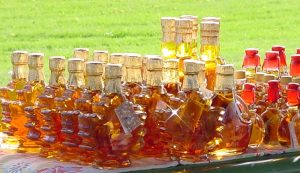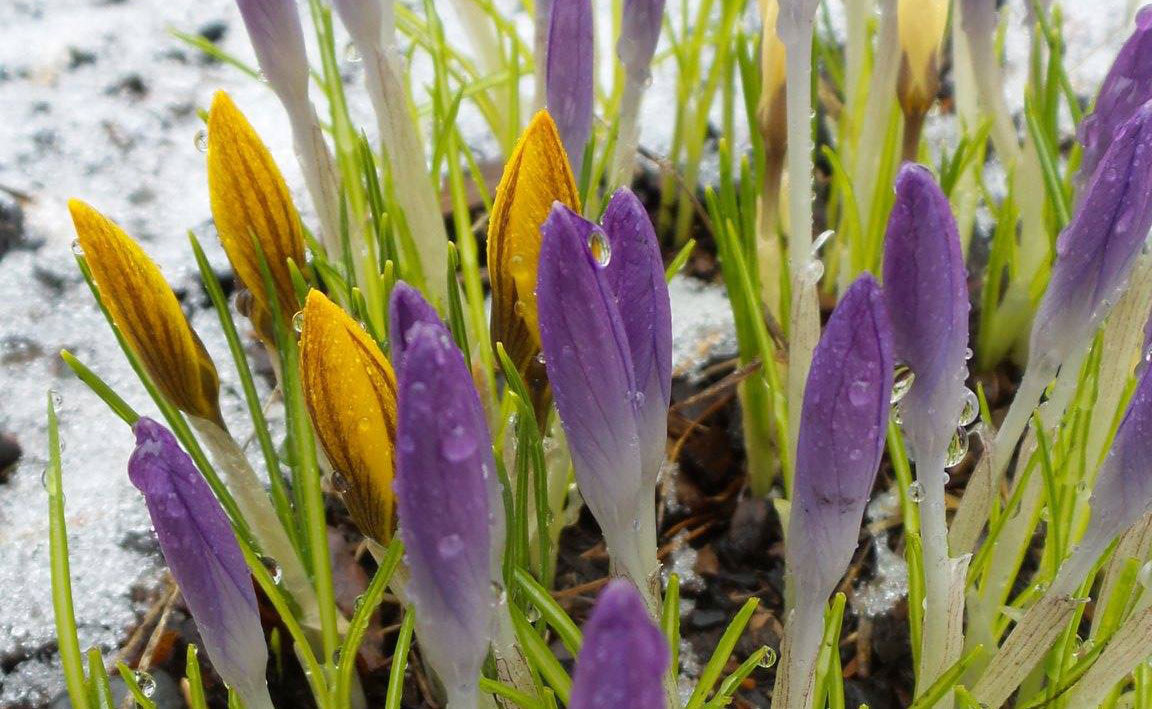
Maine Home Garden News — March 2018
- March Is the Month to . . .
- Practice Pruning Trees and Shrubs this Spring
- Last Chance to help with the Maine Wild Leek Project!
- Sowing the Seeds of Gleaning
- Food & Nutrition: Master Food Preserver: A Decade of Success!
March Is the Month to . . .
By Donna Coffin, Extension Professor, UMaine Extension Piscataquis & Penobscot Counties
SAMPLE SOME SYRUP. March 25th will be Maine Maple Sunday, so pack up the whole family later this month and head out to a local sugar shack for tasty treats. Find out more information at the Maine Maple Producers Website. Or, you can try tapping and making your own syrup from your own sugar maple trees (Acer saccharum), also known as rock or hard maple. Learn how.
START SELECTED SEEDS. Check out our bulletin on Starting Seeds to learn how to do it like a pro and then get down to business. If you need some idea for where to start your seeds, check out UMaine’s video on Starting a Seeding Stand.
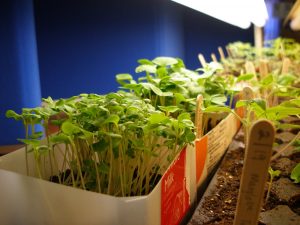 The following is a list of some crops that should be started by seed indoors at some point this month.
The following is a list of some crops that should be started by seed indoors at some point this month.
- Early to mid March: celery, celeriac, leeks, parsley, peas, delphinium, butterfly weed (Asclepias), foxglove (Digitalis), sweet William(Dianthus), pansy (Viola), and eucalyptus.
- Mid to late March: cabbage, collards, kale, kohlrabi, lettuce, mustard, drumstick flower (Craspedia), angel’s trumpet (Datura), yarrow, verbena, stock, snapdragon, black eyed Susan (Rudbeckia), petunia, hollyhock, and blanket flower.
- Late March to early April: artichoke, beets, broccoli, cauliflower, eggplant, swiss chard, ageratum, sweet annie (Artemisia), aster, bells of Ireland,calendula, cardoon, bachelor’s buttons (Centaurea), globe amaranth (Gomphrena), ornamental kale, larkspur, bee balm (Monarda), phlox, Iceland poppy, sanvitalia, statice, strawflower, sweet pea, and black eyed Susan vine (Thunbergia).
PRUNE certain woody landscape plants. Pruning improves ornamental value, helps reduce disease pressure, improves overall plant health, and makes plants easier to manage. For tools, techniques and tips on pruning read Pruning Woody Landscape Plants.
SHARPEN your garden tools to get ready for the season. It’s a good time to service your lawn mower and other power equipment to be sure they are in good running order.
SOIL TESTING should be done as soon as the snow melts if you haven’t tested your garden soil in the past three years. We have the soil test forms and boxes in our offices. How do you do it? Check out Testing Your Soil.
RECYCLE your gardening magazines by sharing with others. Local schools, senior citizen housing, senior centers or even the local laundromat are good places to share magazines.
FORCE BRANCHES. Get a head start on spring blossoms and bring welcome color back into the home by forcing some branches from the garden to bloom. Find out how to accomplish this wonderful chore and peruse what plants will respond to your forceful ministrations in the Purdue University, Forced Branches Bring Spring Indoors.
Practice Pruning Trees and Shrubs This Spring
By Marjorie Peronto, Extension Educator, UMaine Extension Hancock and Washington Counties
Each year in early spring Hancock County Cooperative Extension offers a four-part Pruning Woody Landscape Plants course on Saturday mornings. It’s an opportunity to gain some experience pruning a wide variety of plants, including ornamental shrubs, small flowering trees, small fruits (highbush blueberries, raspberries, blackberries, grapes) and fruit trees. The course is taught by Extension faculty members Marjorie Peronto and David Handley, Horticulturist Reeser Manley, and Orchardist Brett Johnston. We gather weekly at the Hancock County Extension Office in Ellsworth to review the fundamentals of pruning particular types of plants and then head out to a nearby location to practice pruning. This year’s class is full, but to get on the waiting list for next year, contact the Hancock County Extension Office at 1.800.287.1479. For more information visit the UMaine Extension Hancock County website.
Pruning Your Young Tree
Now is the time of year to prune young trees in your landscape.

If you planted a tree in the last year or two, take a close look at its branching structure now. Trees that we bring home from nurseries have usually been pre-pruned to encourage a proliferation of lateral branches. To the consumer, they look full and healthy. But allowing that tight branching structure to remain as the tree ages will result in stress for the tree. Problems will occur as the closely spaced branches grow larger in diameter, exerting pressure on each other while becoming weak and susceptible to breakage when loaded with ice or snow.
Keep your pruning to a minimum at planting time and during the establishment period (one year for every inch of trunk diameter). Holding off pruning during the establishment period allows the tree to retain the most foliage to nourish the developing root system.
Selecting the permanent scaffold branching system of a tree when it is young is called formative pruning. Do this when the tree is established in its new home, but while it’s still young. Branches you remove at this time are still small and small wounds heal quickly.
What to look for:
When you look at your tree, think down the road a few years, imagining each branch increasing in diameter. Remember that the space between branches remains the same as the tree grows.
Your task is to thin crowded branches, allowing the remaining scaffold limbs sufficient room to develop along the trunk. For smaller tree species, such as crabapples, the ideal vertical spacing between branches should be at least six inches apart in a spiral arrangement up the trunk, with a foot between branches on the same side of the trunk. Branches on large tree species like oak and maple should be at least 18 inches apart with about three feet between branches on the same side of the trunk.
Try not to remove more than 1/3 of the canopy in one year. Formative pruning on a very crowded tree can take two to three years, so think through your long-term strategy.
Think about the following when deciding which branches will become the permanent scaffold, and which branches should be removed:
KEEP
- the branch that has a strong union to the trunk (60 to 90 degree angle of attachment, branch should be thinner than the leader).
- the healthy branch that has adequate space around it.
- the branches whose points of origin spiral upwards around the trunk.
REMOVE
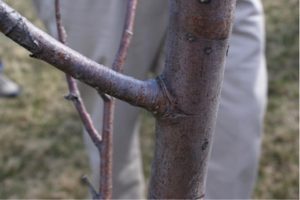
- the branch that has a narrow angle of attachment to the trunk (it is more subject to breakage over time).
- one of two branches that are crossing or rubbing each other.
- the branch that is broken or diseased.
- the branch whose growth is directed inward towards the center of the canopy.
- the branch that is vigorously growing straight up through the canopy, competing with the central leader of the tree.
How to remove a branch:
When removing a small to medium sized branch, locate the swollen area of bark at the point of attachment to the trunk. This area is called the branch bark ridge and branch collar. Cut the branch off just outside this swollen area, leaving the bark ridge and branch collar intact. The bark ridge and branch collar form a natural protection zone that compartmentalizes the wound and promotes healing.
For more information, view Pruning Ornamental Trees and check out UMaine Cooperative Extension Bulletin Pruning Woody Landscape Plants.
Last Chance to Help with the Maine Wild Leek Project!
By Dave Fuller, Agriculture and Non-Timber Forest Products Professional, UMaine Extension Franklin County
Wild leeks, also known as ramps, are a tasty herbaceous perennial with very scant distribution in Maine. The Maine Natural Areas Program lists wild leeks as a plant of special concern.
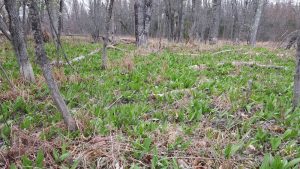
Wild leeks are in the Allium family along with other members including onions, garlic and chives. Emerging in April, wild leeks prefer locations along streams and rivers in the understory of hardwood trees such as maples and ash and adjacent hillsides.
Identification of wild leeks is easy. They are a monocot, so they have parallel leaf veins. The simple, dark green leaves are about eight inches long and about two to three inches wide. Wild leeks tend to form colonies – where you find one, you’ll find many (see image 1). Try pinching a small piece of the leaf – it will smell distinctly of onion/garlic.
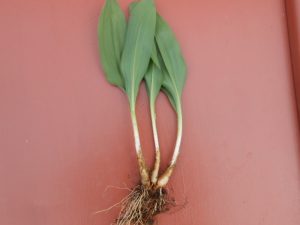
Wild leeks propagate from seeds and by directly-connected underground stems called rhizomes (see image 2). They spread very slowly in part because it takes about seven years to produce a seed-bearing plant from a planted seed. Wild leeks are an excellent example of a spring ephemeral. Their tops die back in June, then mature plants will send up a flower stalk with an umbel of small white blossoms with six petals. The black, shiny seeds that result may stay on the stalk until the following spring.
Harvesting of wild leeks should be done in great moderation. Research has shown that no more than 1% of a population should be removed to ensure a sustainable harvest. Cherokee people and harvesters in the Ukraine only pick some of the leaves of a plant leaving remaining leaves and the small, slender bulb to survive and grow again.
As a result of the Maine Wild Leek Project, wild leeks have been found in most unlikely places such as in the middle of a managed wild blueberry field and under oaks beside the ocean. More than a dozen new locations have been added to the known list of wild leek spots adding to the knowledge base of this wonderful spring ephemeral. Won’t you help log new findings in the last year of this project?
The Maine Wild Leek Project would like to enlist your help as a citizen scientist to document the distribution of wild leeks in Maine. To log locations of wild leeks, please use this form.
Information on location of wild leeks is confidential and will not be distributed.
Sowing the Seeds of Gleaning
By Lynne M. Holland, Community Education Assistant, UMaine Extension Androscoggin-Sagadahoc Counties
Spring is not only the time to plant seeds, but also the idea of GLEANING. What is gleaning you ask? The term, dating back to biblical times, refers to gathering what is left in fields after the harvest. In modern times, it also refers to farmers allowing volunteers to harvest, dig, or collect fresh produce that they do not plan to sell. Gleaning volunteers are increasingly inspired to take action because of heightened awareness of our nation’s food security and food waste challenges, but there’s always a need for more people to get involved.
Farmers want gleaners
There are many reasons a farmer may welcome a relationship with gleaners. Sometimes crops ripen too early or too late for the intended market. There may be no labor available to harvest the crop or a labor shortage forces the farmer to choose between two crops to bring in from the field. The edible remains of some crops left in the field might need extra effort to harvest that is just not worth the price the farmer will get (ex: side shoots of broccoli, third picking of beans, small potatoes that fall through the mechanical harvester, etc.). Lastly, sometimes crops simply don’t sell at the farmers’ market and will not keep in storage until the next market opportunity. No matter what calls farmers to connect with gleaners, they all share a similar interest in making sure as much of the high-quality food they work hard to produce nourishes their community.
Volunteers make it all happen
Through various partnerships around the state, hundreds of UMaine Cooperative Extension Maine Harvest for Hunger Volunteers glean fields and farmer’s markets — bringing food to local pantries, shelters, meal programs and other outlets to feed the hungry. Gleaning volunteers fall into two broad categories: recurring and one-time (a.k.a. project-based) volunteers. Each category share similarities.
Recurring volunteers tend to spend 2-5 hours a week in the field during harvest season. They are willing to get their hands dirty by actually harvesting and transporting the food from the field to a local destination such as a pantry or a centrally located storage facility. Many times that volunteer will be at the same farm each week so a relationship with the farming community develops. Although it is physical work, it is not usually more than a couple hours a day, once or twice a week. Volunteer recruitment is often done through sign-ups at community events. “Glean with a Friend” day where current volunteers are encouraged to bring a friend is also a great recruitment tool. Some gleaners treat it as time to be with a friend and also help the greater community. Many UMaine Cooperative Extension Master Gardener Volunteers have become very dedicated recurring volunteers. Avid gardeners make great gleaners!
Recurring gleaners are also key to successful farmers market gleaning programs. These gleans can be done without getting your hands dirty. People who can’t do heavy lifting or bending can still pull a wagon around the market at closing and collect donated food. Depending on the size of the market, it takes one to three people less than a couple of hours and the results tend to be consistent week to week. Success depends on 1) establishing rapport with the farmers in advance, and 2) having a destination for the perishable product right after the market closes. The Merrymeeting Gleaners worked out the use of a “cold room” and several refrigerators for the product gleaned from the Brunswick Winter Market each week. The product is divided up for delivery first thing Monday to sixteen different outlets. In the summer they will use a “cool bot” trailer to keep product in overnight for pick-up by the pantries in the morning.
One-time (aka project-based) gleaners are typically involved in gathering crops that are harvested all at once or at the end of the season for a specific crop. Because of the short commitment, these opportunities can serve as a great chance to connect with new volunteer audiences. One crop that is always welcome at a pantry are berries. School-age children with good supervision can pick strawberries, blueberries or raspberries very quickly and easily. Recruiting them through summer programs, scouts, 4-H Clubs, Boys and Girls clubs etc. takes planning and time. Start now by having conversations with local host farms and sharing the idea with leaders of youth programs. Build enthusiasm by sharing the lessons and rewards the kids will get from doing the project. Keep the teams small and manageable and then, as the time draws closer (early to mid July for strawberries, late July or early August for Raspberries and August for Blueberries) keep in touch with the farmer so that as the pick-your–own fields close your teams can come in and glean the what is left. Fall crops are also well suited to this type of gleaning. Here is where teams from local businesses or organizations can really help. Apples, potatoes and squash are all heavier and better suited to teens or adults. This is where Big Brother/Big Sisters type groups, college clubs, businesses or church groups can be a place to seek volunteers. These types of harvests can often be done one or two times and can be done in a two-four hour timeframe. They are great for encouraging friendly competition. Again, planning is the key here. Many scout, school and other groups plan their fall activities many months in advance. Large businesses often reward workers who do community service and getting on their radar screen as a service opportunity can take some time.
With a shared passion for getting fresh food to neighbors in need and minimizing food waste, gleaning programs attract a lovely team of people to work towards a common cause. It’s a great way to meet new friends and make a positive impact in the community. If you see yourself or your organization fitting into this picture, contact your local Cooperative Extension Office to connect with a gleaning or Harvest for Hunger project in your area. The Maine Gleaning Network website (look under the NETWORK tab) is also a great way learn how to get involved.
Want to experience more love for gleaning?
- Enjoy this video on the Merrymeeting Gleaners.
- Check out an article from the perspective of a passionate gleaning volunteer.
- For more information see Food for ME fact sheet series.
Food & Nutrition: Master Food Preserver Program: A Decade of Success!
By Kathy Savoie, MS, RD, Extension Educator, UMaine Extension Cumberland County
UMaine Cooperative Extension’s Master Food Preserver (MFP) Program was honored recently at the National Extension Association of Family and Consumer Sciences (NEAFCS) 2017 annual conference, “Harvesting Opportunities in NEAFCS”. Master Food Preservers are volunteers trained to extend Extension’s education programs in food preservation to adults and youth. They provide the public with research-based information from the University of Maine Cooperative Extension and USDA.
Accolades from the NEAFCS conference last fall included 1st place National and 1st place Regional Master Family and Consumer Sciences (FCS) Volunteer Award. Both NEAFCS and the National Institute of Food and Agriculture recognized the MFP Program for impacts that span a decade. The Master FCS Volunteer Award recognizes exceptional leadership in implementation of the Master FCS Volunteer Program.
The MFP training involves lectures, discussions and hands-on kitchen lab experiences covering the following topics:
- the latest information on food safety and food preservation;
- prevention of foodborne illness;
- food storage and safety;
- canning basics;
- canning acid foods;
- canning low-acid foods;
- pickled and fermented foods;
- preserving jams and jellies;
- freezing foods; and
- drying food products.
Through an application process, any Maine resident 21 years or older is eligible to take the Master Food Preserver course. To become a Master Food Preserver, accepted applicants must meet the following qualifications:
- Attend the 10-part, 35-hour Master Food Preserver course including hands-on kitchen lab sessions.
- Complete lab quizzes and pass the final written exam.
- Complete at least 20 hours of volunteer service as a Master Food Preserver.
- Complete quarterly reports on the number of public contacts made.
here is more information if you are interested in becoming a part of the 2018 Master Food Preserver Program.
University of Maine Cooperative Extension’s Maine Home Garden News is designed to equip home gardeners with practical, timely information.
Let us know if you would like to be notified when new issues are posted. To receive e-mail notifications fill out our online form.
For more information or questions, contact Kate Garland at katherine.garland@maine.edu or 1.800.287.1485 (in Maine).
Visit our Archives to see past issues.
Maine Home Garden News was created in response to a continued increase in requests for information on gardening and includes timely and seasonal tips, as well as research-based articles on all aspects of gardening. Articles are written by UMaine Extension specialists, educators, and horticulture professionals, as well as Master Gardener Volunteers from around Maine, with Katherine Garland, UMaine Extension Horticulturalist in Penobscot County, serving as editor.
Information in this publication is provided purely for educational purposes. No responsibility is assumed for any problems associated with the use of products or services mentioned. No endorsement of products or companies is intended, nor is criticism of unnamed products or companies implied.
© 2018
Call 800.287.0274 (in Maine), or 207.581.3188, for information on publications and program offerings from University of Maine Cooperative Extension, or visit extension.umaine.edu.

